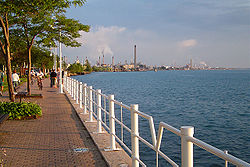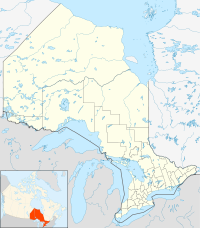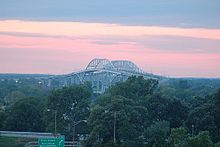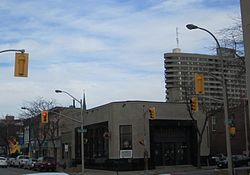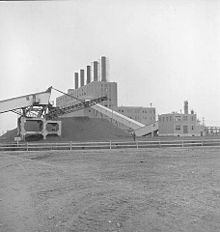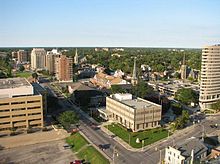- Sarnia
-
For other uses, see Sarnia (disambiguation).
Sarnia — City — Walking trail next to the St. Clair River in Sarnia. Motto: Sarnia Semper
(Latin for "Sarnia Always")Coordinates: 42°59′N 82°22′W / 42.983°N 82.367°WCoordinates: 42°59′N 82°22′W / 42.983°N 82.367°W Country  Canada
CanadaProvince  Ontario
OntarioCounty Lambton County Settled 1830s Incorporated June 19, 1856 (town) Incorporated May 7, 1914 (city) Government – City Mayor Mike Bradley – Governing Body Sarnia City Council – MPs Pat Davidson (CPC) – MPPs Bob Bailey (OPC) Area[1][2] – Land 164.63 km2 (63.6 sq mi) – Metro 799.77 km2 (308.8 sq mi) Elevation 191 m (627 ft) Population (2006)[1][2] – City 71,419 – Density 433.8/km2 (1,123.5/sq mi) – Metro 88,793 – Metro density 111.0/km2 (287.5/sq mi) Postal code span N7S, N7T Area code(s) 519 and 226 Website www.sarnia.ca Sarnia is a city in Southern (Southwestern) Ontario, Canada (city population 71,419, census area population 88,793, in 2006). It is the largest city on Lake Huron and is located where the upper Great Lakes empty into the St. Clair River.
The city's natural harbour first attracted the French explorer La Salle, who named the site "The Rapids". The name "Sarnia" was the Latin name for Guernsey in the Channel Islands just off the coast of Normandy, France. The Sarnia port is still an important centre for lake freighters and "salties" carrying cargoes of grain and petroleum products. It is the largest community in Lambton County.
The natural port and the salt caverns that exist in the surrounding areas, coupled with the oil discovered in nearby Oil Springs lead to the massive growth of the petroleum industry in this area. Since Oil Springs was the first place in Canada and North America to commercially drill for oil, the knowledge that was acquired there and strengthened in Sarnia led to Sarnians traveling the world teaching other nations how to drill for oil.[citation needed] The complex of refining and chemical companies located downriver of downtown Sarnia once adorned the back of the Canadian ten-dollar bill and are the reason that the World Health Organization named Sarnia the most polluted city in Canada [3].
Sarnia is a border city, on the Canadian side of the Blue Water Bridge linking Sarnia's neighbouring village of Point Edward to the city of Port Huron, Michigan in the United States of America. The Blue Water Bridge spans the St. Clair River, which connects Lake Huron to Lake St Clair. The original three-lane span, which was opened in 1938, was twinned in the 1990s, making the bridge the largest infrastructure-crossing project in North America. The Blue Water Bridge border crossing makes use of both the NEXUS (frequent traveler program) and the Free and Secure Trade (FAST) program.
Contents
Name
From "The Rapids" to "Port Sarnia" to "Sarnia", the city has undergone many changes—from a First Nations hunting ground to an up-and-coming settlement and an industrial centre. In 1812, Sir John Colborne was appointed Governor of the Isle of Guernsey, one of the Channel Islands. In 1829, the area and Townships of Sarnia and Moore were surveyed by Boswell Mount, and named by Sir John Colborne.
Previously thought to be the Roman name for the Isle of Guernsey, it has now been found that the name Sarnia has a Celtic origin.
In 1835, Colborne paid his first visit to what is now the city of Sarnia, then known as The Rapids. Previous to his visit, the villagers had decided that a change of name was necessary, but found it impossible to agree on a new name. The English settlers favoured the name "Buenos Aires" and the Scottish "New Glasgow". To break the deadlock, Sir John Colborne suggested Port Sarnia and on January 4, 1836, the name was formally adopted by a vote of 26 to 16.
A year previous to the adoption of the name Port Sarnia, the village was composed of 44 taxpayers, 9 frame houses, 4 log houses, 2 brick dwellings, 2 taverns and 3 stores. An Act to Incorporate the Town of Sarnia was assented to on June 19, 1856. The name Port Sarnia was officially changed to Sarnia effective January 1, 1857. The population of the Town was mentioned in the Act at upwards of 1,000 inhabitants and there were three wards.
An Act to Incorporate the City of Sarnia was assented to on April 20, 1914, and Sarnia officially became a city as of May 7, 1914. This day was marked by the visit of Canada’s Governor General, H.R.H. the Duke of Connaught, and his daughter Princess Patricia. It was also on this day that Sarnia adopted the title of "The Imperial City". The population of the city was mentioned at 10,985 in the Act, and there were six wards.
On January 1, 1991, Sarnia and the neighbouring town of Clearwater were amalgamated as the new city of Sarnia-Clearwater. The amalgamation was originally slated to include the village of Point Edward, although that village's residents resisted and were eventually permitted to remain independent of the city. On January 1, 1992, the city reverted to the name Sarnia.
History
The early growth of Sarnia was stimulated by the wealth of adjoining stands of timber, by the discovery of oil nearby and by the arrival of the Great Western Railway in 1858 and the Grand Trunk Railway in 1859. These rail lines were later linked directly to the United States by the opening of a rail tunnel under the St. Clair River at Sarnia in 1889. A convenient link for vehicular traffic was provided when the Blue Water Bridge was opened in 1938.
For many years Alexander Mackenzie, who later became the second Prime Minister of Canada, was an editor of the Sarnia Observer. He had set off to Sarnia during the year of 1845, when he had met a lord's daughter and set up a business. He died in Toronto in 1892, aged 70, from a stroke related to a fall and was buried in Sarnia.
Sarnia became a prominent deep water port during the 1920s when many of the shipping facilities that exist today were constructed, including the winter harbour, the elevator slip and the large grain elevators.
While there had been a petroleum industry in the Sarnia area since the mid-19th century, the establishment of the Polymer Corporation in 1942 to manufacture synthetic rubber during World War II was the first step in establishing Sarnia as a major petrochemical centre.
Neighbourhoods
The city includes the neighbourhoods of Blackwell, Bright's Grove, Froomfield, Lucasville, and Mandaumin.
Climate
The climate of Sarnia is considered mild for Canadian standards. Winters are cool but not very cold, spare for a few short-lasting Arctic air masses that dip so far south and bring with them daily high temperatures lower than −10 °C and, usually, a large amount of lake-effect snowfall. This phenomenon accounts for much of Sarnia's annual snowfall. Otherwise, Sarnia is not often affected by lake-effect snowfall, a result of its position at the southern tip of Lake Huron. Areas east of Lake Huron, such as London and Goderich, tend to get considerably more snow than Sarnia. Summers are warm to hot and usually humid. Humidex readings can be very high at times from late May to late September. Thunderstorms can become quite severe from April to September. Destructive weather is very rare in the area but has occurred, such as the tornado event of 1953.
Lake Huron moderates the city in several ways. It creates a seasonal lag: compared to the rest of Canada and to inland Ontario, Sarnia has a noticeably longer warm period following summer. However, cooler temperatures tend to prevail for longer after winter. Lake Huron can also create large temperature differences within the city in spring and early summer, particularly on hot days in Late May, Early June. Finally, extreme temperatures, particularly lows, are rarely ever seen. Weather in the Great Lakes Region tends to be more predictable than any other non-coastal area of the continent.
Climate data for Port Huron, MI, USA and Sarnia, ON, Canada Month Jan Feb Mar Apr May Jun Jul Aug Sep Oct Nov Dec Year Record high °C (°F) 17.8
(64.0)20.6
(69.1)26.6
(79.9)30.6
(87.1)35.6
(96.1)39.1
(102.4)38.9
(102.0)37.7
(99.9)37.2
(99.0)32.2
(90.0)27.2
(81.0)18.9
(66.0)39.1
(102.4)Average high °C (°F) −0.9
(30.4)0.6
(33.1)5.8
(42.4)12.9
(55.2)19.4
(66.9)25.1
(77.2)27.3
(81.1)26.8
(80.2)23.1
(73.6)15.9
(60.6)8.5
(47.3)2.3
(36.1)13.9 Average low °C (°F) −7.9
(17.8)−7.4
(18.7)−3.1
(26.4)2.6
(36.7)8.4
(47.1)14.2
(57.6)17.1
(62.8)17
(63)12.8
(55.0)6.5
(43.7)1.1
(34.0)−4.4
(24.1)4.7 Record low °C (°F) −28.3
(−18.9)−23.9
(−11.0)−21.7
(−7.1)−13.3
(8.1)−2.8
(27.0)1.7
(35.1)5.6
(42.1)4.4
(39.9)−1.1
(30.0)−6.7
(19.9)−16.6
(2.1)−21.7
(−7.1)−28.3
(−18.9)Precipitation mm (inches) 50.1
(1.972)47.7
(1.878)62.6
(2.465)75.4
(2.969)69.9
(2.752)85.6
(3.37)74.1
(2.917)77.1
(3.035)94
(3.7)66
(2.6)76.4
(3.008)68
(2.68)846.8
(33.339)Source no. 1: Weather Warehouse (normals from 1980-2009, records from 1950-2010)[4] Source no. 2: Environment Canada[4] Development
The growth of the city received a major boost when North America's first oil discovery was made at nearby Oil Springs in the 1850s. In 1938, the Blue Water Bridge was built to join Sarnia with Port Huron, Michigan; in 1997, the bridge was twinned. Today linking Ontario Highway 402 with the US I-94 and I-69, the bridge is one of the most important gateways on the north/south truck routes. This bridge to the United States had been preceded by the construction of the St. Clair tunnel in 1891—the first rail tunnel ever to pass under a river. The tunnel was an engineering marvel in its day, achieved through the development of original techniques for excavating in a compressed air environment. A new tunnel which accommodates double-stacked rail cars was bored and began operation in 1995. It is located next to the original tunnel, which has been sealed.
When World War II threatened tropical sources of natural latex for rubber, Sarnia was selected as the site to spearhead development of synthetic petroleum-based rubbers for war materials, and Polymer corporation was built by Dow Chemical at the request of the Government of Canada.[5] Large pipelines bring Alberta oil to Sarnia, where oil refining and petrochemical production have become mainstays of the city's economy. Shell Canada, Imperial Oil, and Suncor Energy (Sunoco) operate refineries in Sarnia. Large salt beds found under the city became a source of chlorine and another significant ingredient in the success of the "Chemical Valley". Chemical companies operating in Sarnia include NOVA Chemicals, Bayer (Lanxess and H.C. Starck), Imperial Oil, Royal Group Technologies, Cabot Corporation and Ethyl Corporation.
Dow ceased the last of its operations at its Sarnia site in 2009. The plant was decommissioned, and the land has been sold to neighbouring TransAlta Energy Corporation. TransAlta produces power and steam for industry, and is the largest natural gas co-generation plant in Canada. TransAlta has created the Bluewater Energy Park on the former Dow site.
Lanxess is the sole producer of approved food-grade butyl rubber, which is used to make chewing gum, and its Sarnia facility is the only one which currently makes the material.[6] Lanxess has created the Bio-industrial Park Sarnia within the boundaries of its Sarnia plant.
Sarnia is the location of Enbridge's Sarnia Photovoltaic Power Plant. The facility went into full commercial operation in December 2009, with 20 MW of power. In December 2009 the company announced an additional 60 MW expansion at that site. When completed in 2010 it became the largest photovoltaic (PV) solar power generation facility in the world.
In November 2003 the City of Sarnia, County of Lambton, and the University of Western Ontario announced the creation of The Research Park, Sarnia-Lambton Campus. The Research Park is also the location of the Bioindustrial Innovation Centre, Canada’s centre for the commercialization of industrial biotechnology.
While industry expanded south along the St. Clair, Sarnia's population tended to move out eastward along the Lake Huron shoreline. The sandy fresh water beaches are a popular tourist attraction, while the sheltered harbour houses marinas for recreational sailing. Since 1925, the 400 km Mackinac race from Sarnia/Port Huron to Mackinac Island, at the north end of the lake, has been the highlight of the sailing season, drawing more than 3000 sailors each year.The City of Sarnia and County of Lambton are implementing an economic development plan with an emphasis on bioindustries and renewable energy.
Film industry
Portions of several films have been shot in Sarnia. Scenes from the 1994 film Renaissance Man and the 2000 film Bless the Child were both filmed at the Blue Water Bridge.
In 2002, Michael Moore filmed segments of his documentary Bowling for Columbine in Sarnia. He interviewed residents outside the local Taco Bell, the plaza beside it, the Famous Players' Lambton 9 movie theater and at a gun show in nearby Point Edward. In the summer of 2004, Sarnia mayor Mike Bradley (who was also interviewed in the film), offered to name Moore an honorary citizen of Sarnia. In his 2007 film Sicko, Michael Moore returned to Sarnia to film and interview his relatives at Sears and in the Marina restaurant at the former St. Clair Parkway site.[7][8]
Government
Sarnia City Council consists of nine elected members: the Mayor and four members from the city and county. The Mayor and all Council members are elected to four year terms. The four Lambton County Council members serve both County and City Council while the four Sarnia City Councillors do not.
The current mayor, Mike Bradley, has held the position since 1988 and is the longest-serving mayor in the city's history. Past mayors of the city have included Andy Brandt, Marceil Saddy, Paul Blundy and Thomas George Johnston.
Right now, the foursome of Sarnia City and County Councillors are Dave Boushy, Jim Foubister, Bev MacDougall and Anne Marie Gillis. The quartet of Sarnia City Councillors presently representing citizens includes Andy Bruziewicz, Jon McEachran, Mike Kelch and Terry Burrell.
At the provincial level, Sarnia is located within the Sarnia—Lambton provincial electoral district which is currently represented by Bob Bailey, a member of the Progressive Conservative Party of Ontario. At the federal level, Sarnia is located within the Sarnia—Lambton federal electoral district which is currently represented by Patricia Davidson of the Conservative Party of Canada.
Education
The Lambton Kent District School Board is responsible for the 13 elementary and four secondary public schools (Northern Collegiate Institute and Vocational School, Alexander MacKenzie Secondary School, Lambton Central Collegiate & Vocational Institute, Sarnia Collegiate Institute & Technical School and St. Clair Secondary School) located within Sarnia's boundaries.
The St. Clair Catholic District School Board is responsible for the city's seven elementary and two secondary Catholic schools (St. Christopher's and St. Patrick's). Both boards also provide French immersion education.
The Conseil scolaire de district des écoles catholiques de Sud-Ouest represents the two French Catholic schools in the city, Saint-François-Xavier and Saint-Thomas-d'Aquin, while the Conseil Scolaire de District du Centre Sud-Ouest operates two French public schools, the elementary École Les Rapides and the secondary École Secondaire Franco-Jeunesse.
There are also three independent Christian elementary schools in Sarnia: Sarnia Christian School, Temple Christian Academy and Bluewater Lighthouse Christian Academy. A new Christian highschool, Patmos College, was opened in September 2007.
Lambton College is one of Ontario's 21 colleges of applied arts and technology. It has a full time enrollment of 2,500 and a part-time enrollment of about 8,000. It is the city's only post-secondary school.
In 2005, the University of Western Ontario opened a research and development park in Sarnia to work on a variety of research innovations.
Media
Radio
Some stations from Windsor, London, Detroit, and The Thumb can also be heard in the region.
- 1070 AM — CHOK, country/news/sports
- 90.3 FM — CBEG, CBC Radio One
- 99.9 FM — CFGX-FM 99.9 The Fox, adult contemporary
- 103.3 FM — CKTI-1, rebroadcaster of First Nations community station from Kettle Point
- 103.9 FM — CHOK-1 (rebroadcaster of CHOK AM)
- 106.3 FM — CHKS, active rock
Television
Sarnia does not have any originating television stations of its own, although the city does have rebroadcasters of several television stations originating in other markets, as well as the ability to directly receive stations from Windsor, Detroit and London.
- Channel 42 — CKCO-3, CTV (maintained an office in Sarnia, and a permanent reporter, Rick Smith. Office closed down August 31, 2009.)
- Channel 51 — CHCH-2, independent
- Channel 59 — CICO-TV-59 (TVOntario)
- Channel 68 — CBLFT-17, Radio-Canada
Sarnia has a community channel, TV Cogeco, on Cogeco Cable.
Newspapers
The city's main daily newspaper is the Sarnia Observer, owned by Osprey Media. The community publications Sarnia This Week, Lambton County Smart Shopper and Business Trends are owned by Bowes Publishing. The monthly business oriented newspaper First Monday is owned by Huron Web Printing and Graphics.
Magazines
Sarnia features a monthly arts and entertainment magazine called Fix Magazine.
Weather information
Environment Canada has a 24 hour broadcast that can be heard over Weather Radios and many two-way radios and scanners.
Emergency information
Due to the risk of hazardous materials incidents (chemical emergencies) occurring in the industrial corridor south of Sarnia, four sirens have been placed in Sarnia south of Wellington Road, three more on nearby Aamjiwnaang First Nation, three in Corunna, and one in Point Edward.[9] In the event of an emergency requiring immediate action by the public, the sirens are sounded for a three-minute period, serving as an alert to the public to seek shelter indoors and to tune to a local radio station for updated instructions. These sirens are tested (and can be heard) every Monday at 12:30pm to ensure proper functioning.
An emergency Command Centre located at the Sarnia Police Station can coordinate deployments of emergency responders during hazardous materials incidents.[10]
Transportation
Sarnia Transit provides public transportation within the City of Sarnia. This includes conventional bus transit, transportation of people with disabilities (Care-A-Van), transportation support for major events, and charter services.
Sarnia Chris Hadfield Airport is located in Sarnia. Air Canada Jazz offers airline service from that airport to Toronto.
Sarnia is served by private cab companies, Canadian Red Cross and Lambton Elderly Outreach.
Sarnia is also one of the two western termini (along with Windsor) of the Via Rail Quebec City-Windsor Corridor, over which there is twice daily service to and from Toronto.[11]
Events
During the Christmas season, the city of Sarnia hosts the annual Celebration of Lights in Centennial Park. It was originally created by Dr. Wills Rawana and a committee whom were funded through the Centre by the Bay and Telus. However, both organizations are no longer affiliated with the event. As of 2006, The St. Clair Parkway has been shut down and is no longer involved with the event either. Rogers Communications now helps with sponsorship.
Sarnia Bayfest, which was preceded by the "Festival by the Bay," is an annual concert festival that features rock bands, typically during the third weekend of July. The festival has included big name acts such as Rush (band), Bon Jovi, The Black Crowes, Mötley Crüe, Kiss, Kid Rock, Aerosmith, Billy Talent, Def Leppard, Our Lady Peace, David Lee Roth, The Foo Fighters, The Guess Who, Blink 182, Sum 41, ZZ Top, Collective Soul, among many others. Bayfest has since added Country and Western acts as it headlined Gretchen Wilson, Keith Urban and Brooks and Dunn with great success.
Bayfest 2009 took place on two weekends in July. The Festival included a Country weekend and Rock weekend. Bayfest 2010 saw the expansion of the festival to include American hip-hop group, The Black Eyed Peas.
Sarnia is home to the Sarnia Legionnaires, the most successful Jr. 'B' hockey team in Ontario history with six championships in 15 seasons as a Jr. 'B' club. It is also home to the Sarnia Sting, an Ontario Hockey League team. Dino Ciccarelli, a former NHL player, is a part owner of the team.
Famous people
Main article: List of people from Sarnia, OntarioDemographics
Census Population 1841 610 1871 2,929 1881 3,874 1891 6,692 1901 8,176 1911 9,947 1921 14,877 1931 18,191 1941 18,599 1951 34,697 1961 50,976 1971 57,644 1981 50,892 1991 74,376 2001 70,876 2006 71,419 Census Data
According to the 2006 Statistics Canada Census:[1]
- Population: 71,419
- % Change (2001–2006): +0.8%
- Median Age: 43.2
- Median Income (persons over 15) [Ontario]: $26,971 [$27,258]
- Median Income (all census families) [Ontario]: $69,731 [$69,156]
- Median Income (couple households - with children) [Ontario]: $94,741 [$87,960]
- Dwellings: 31,610
- Average value of owned dwelling [Ontario]: $175,214 [$297,479]
- Density (persons per km2): 433.8
- Area (km2): 164.63
References
- ^ a b c "Sarnia (city) community profile". 2006 Census data. Statistics Canada. http://www12.statcan.gc.ca/census-recensement/2006/dp-pd/prof/92-591/details/page.cfm?Lang=E&Geo1=CSD&Code1=3538030&Geo2=PR&Code2=35&Data=Count&SearchText=Sarnia&SearchType=Begins&SearchPR=01&B1=All&Custom=. Retrieved 2011-02-22.
- ^ a b "Sarnia (Census agglomeration) community profile". 2006 Census data. Statistics Canada. http://www12.statcan.gc.ca/census-recensement/2006/dp-pd/prof/92-591/details/page.cfm?Lang=E&Geo1=CMA&Code1=562&Geo2=PR&Code2=35&Data=Count&SearchText=Sarnia&SearchType=Begins&SearchPR=01&B1=All&Custom=. Retrieved 2011-02-22.
- ^ "WHO ranks Canada's urban air among best in world". Toronto Star, Sep 26 2011.
- ^ a b Weather Warehouse [1], accessed 30 Nov 2010
- ^ Brandt, E.N. (1997). Growth Company: Dow Chemical's First Century. East Lansing, MI: Michigan State University Press. ISBN 0-87013-426-4.
- ^ "Lanxess' Sarnia plant is the sole source of butyl rubber for chewing gum". http://www.icis.com/Articles/2008/03/31/9111033/lanxess-expands-butyl-rubber-business-in-asia.html. Retrieved 2009-11-19.
- ^ CTV.ca News Staff (2004). "Filmmaker Moore targeted over election remarks". CTVglobemedia. http://www.ctv.ca/servlet/ArticleNews/story/CTVNews/1089846127590_85255327/?hub=Canada. Retrieved 2007-02-25.
- ^ CBC News (July 14, 2004). "Michael Moore broke election law, alleges young Tory". CBC. http://www.cbc.ca/canada/story/2004/07/14/moore_elxn040714.html. Retrieved 2007-02-25.
- ^ CAER's Home Emergency Preparedness Guide
- ^ CAER Community Warning System
- ^ "Toronto-Sarnia train - Schedules". Via Rail. http://www.viarail.ca/en/trains/ontario-and-quebec/toronto-sarnia/schedules. Retrieved 2011-10-24.
External links

Point Edward Lake Huron 
Port Huron, Michigan / St. Clair River 
Plympton–Wyoming  Sarnia
Sarnia 

Marysville, Michigan / St. Clair River Sarnia 45 IR, St. Clair Enniskillen Categories:- Sarnia, Ontario
- Populated places on the Great Lakes
- Port settlements in Ontario
Wikimedia Foundation. 2010.

